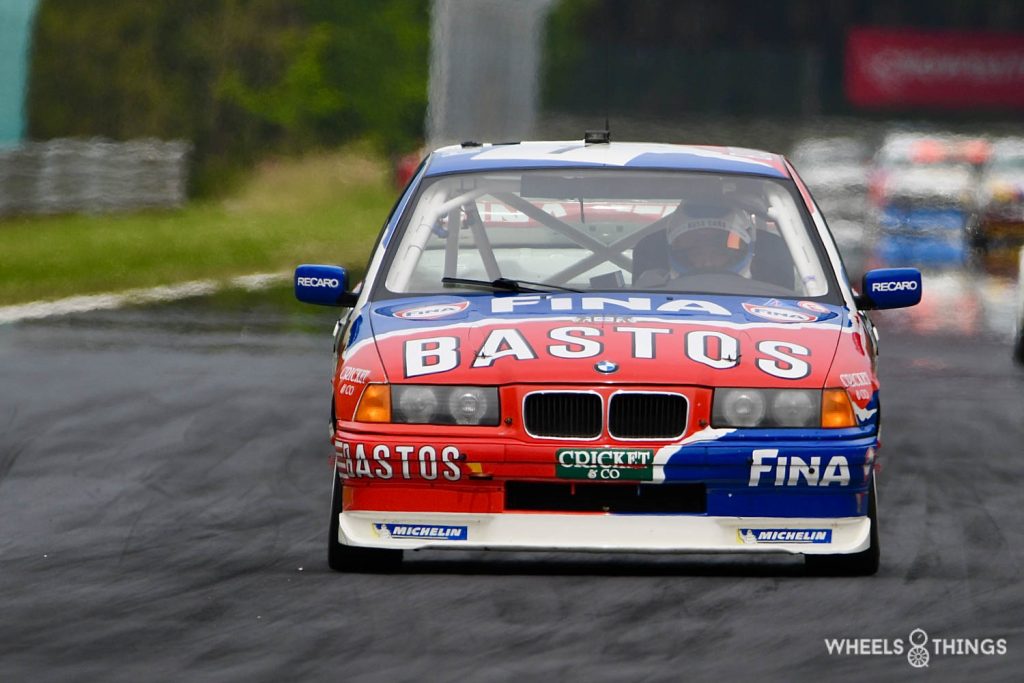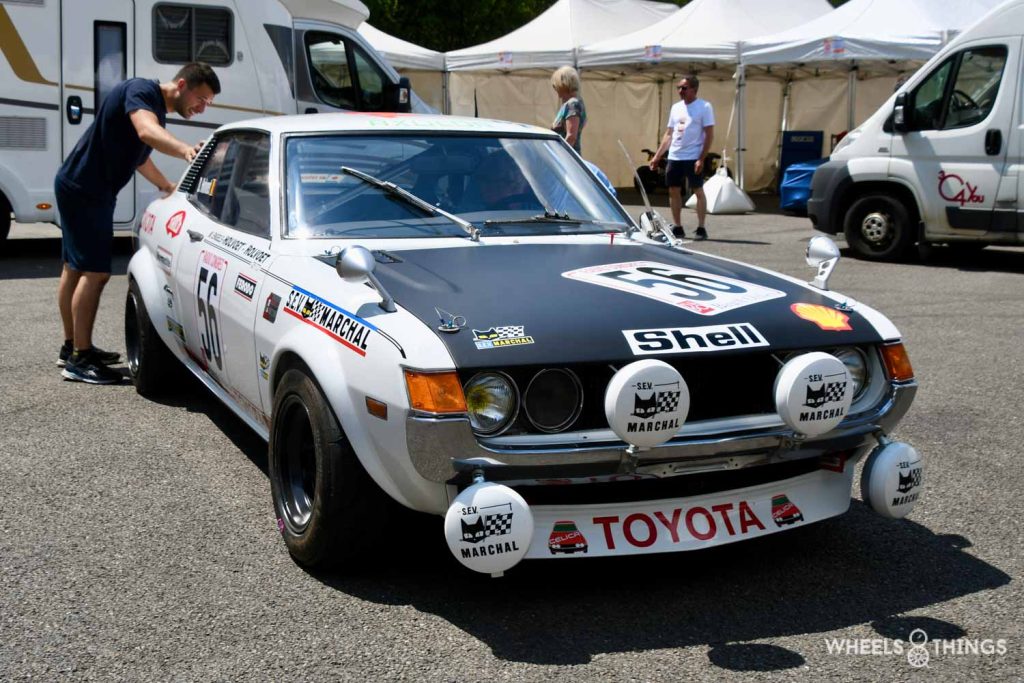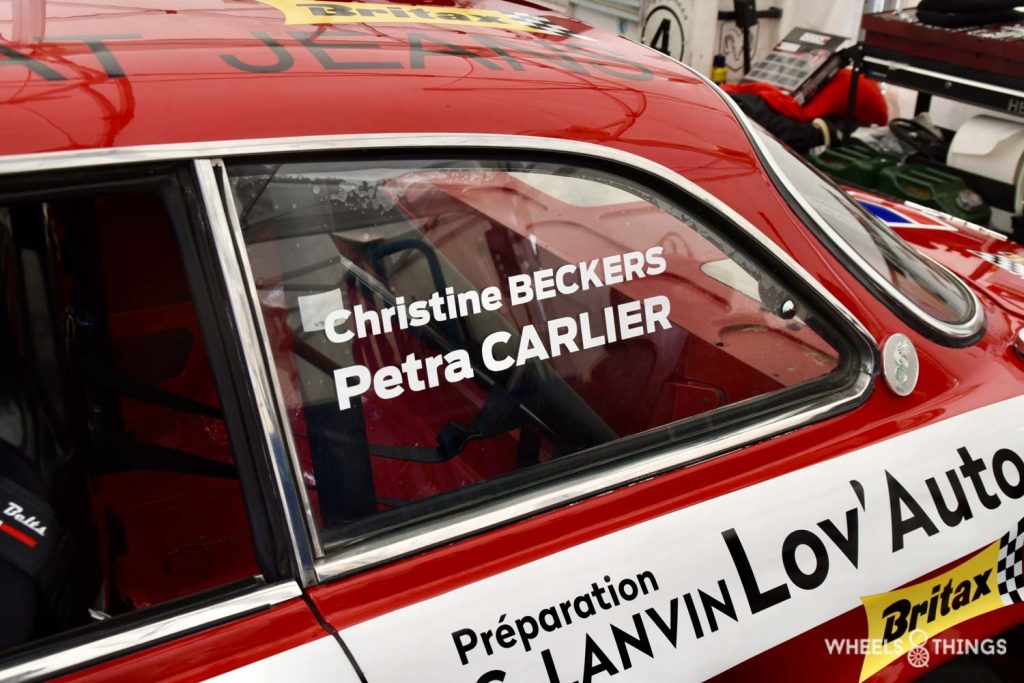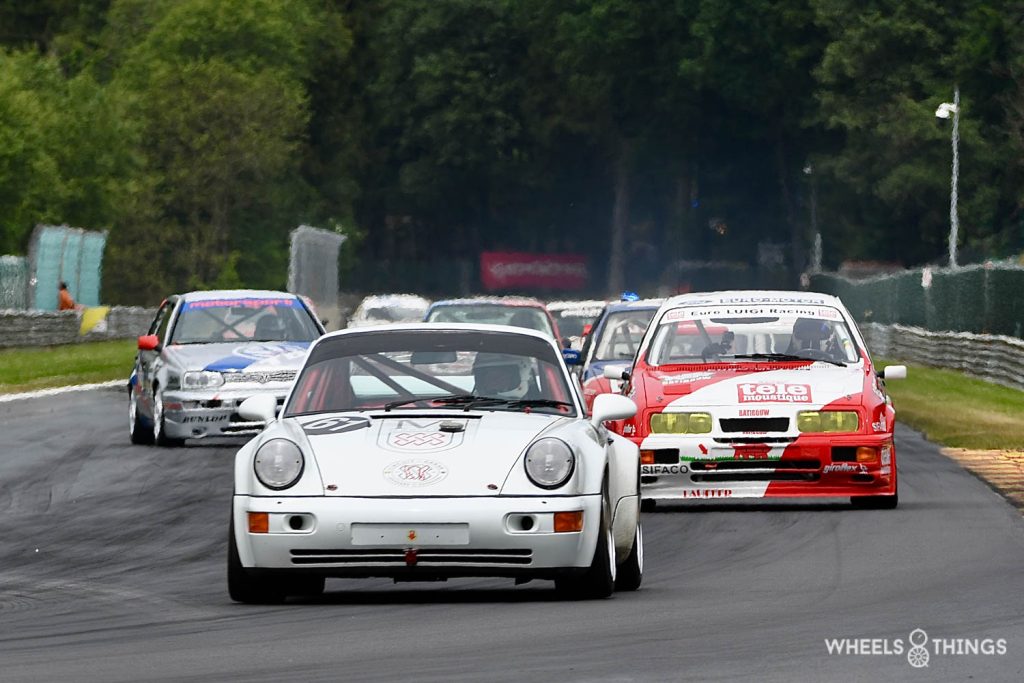Part 1: Heritage Touring Cup.

After the centenary in 2021, of the Francorchamps circuit itself, and last year’s celebration of 100 years of the 24 Hours of Le Mans, it was now the turn of the 24 Hours of Francorchamps to blow out 100 candles.
Indeed, this year marks a century since a 24-hour race was first contested between the triangle of Francorchamps, Stavelot and Malmedy. The Royal Automobile Club of Belgium ( KACB or RACB for the French speakers ) signed up for the organisation.

Stéphane Ratel of SRO and the RACB did not want this to go unnoticed and provided a very nice party. Several historic cars were displayed in the paddock and on the roof of the pit building, the “Gallery Du Temps” was a beautiful exhibition with cars, miniatures, magazines, newspapers, helmets, tickets, stickers, programme booklets and many other items from this 100-year period.

There were also commemorations on the circuit with two races of the Endurence Racing Legends GT cars and one for the Heritage Touring Cup. Two organisers for which our friends at Peter Auto presented.

The 24 Hours of Francorchamps ( later Spa 24 Hours ) has three periods. The first we can safely refer to as the pioneering period which mainly takes place before the Second World War. First winners are Springuel and Becquet with a Bigman. They ride a total of 1879 km in 24 hours in 1924. Their average speed is 78.3 kilometres per hour. The expo featured this replica of a Speedsport, which came sixth at the time. This was followed by victories by Chenard & Walker, Peugeot, Excelsior, Alfa Romeo and Mercedes. Alfa Romeo was the most successful brand until World War II with seven wins. The race was not organised every year then.

There are three more post-war editions from 1948 onwards, with a first win for Aston Martin ( 1948 ) and twice for Ferrari (1949 and 1953 ). After the 1953 edition, the race goes into decline and no more organisations follow.

This will last until 1964. Spurred on by Hubert De Harlez of the KACB and automotive journalist/pilot/Le Mans winner Paul Frère, a new start is made with a race for touring cars. And it is an instant success with a nice starting field and spectators in large numbers. This touring car format will be organised continuously until 2000. There will be heroic duels, often with serious accidents and lots of tragedy. Several drivers lost their lives on the old Francorchamps circuit, with 1973 – 1974 and 1975 in particular as the “black years”.

And what Le Mans was then for the Proto and GT cars, Francorchamps is for the touring cars: the biggest race for this class. But the touring car formula died out in the late 1990s. The regulations at the time, with slightly improved standard cars, could still charm few motorsport fans. A Peugeot 306 or Honda Civic are now not exactly crowd-pleasers for a 24-hour race. The KACB was looking for a solution and the rescue came with Stéphane Ratel of SRO. Who has been organising GT races for some time. Ratel is looking for a crown jewel for his programme. KACB and Ratel come to an agreement and the 24 hours of Francorchamps are saved. Once again, the top teams will find their way to the Ardennes circuit with their beautiful and spectacular GT cars. And with them, spectators will also once again flock to the race. Next year will already be the 25th edition of this renewed formula. We are counting on another great party.
HERITAGE TOURING CUP

To add to this centenary celebration, there were also races featuring old legends. The Heritage Touring Cup welcomed cars that had raced in the 24 Hours of Francorchamps between 1964 and 2000. This race, organised by Peter Auto, was adapted for this festive edition, though. Normally, cars are allowed to participate up to 1986. For the centenary, the more recent Group A cars ( such as the BMW M3 and the Sierra Cosworth ) and the later Super Touring Cars ( e.g. the BMW 320i because there were no other starters ) were also admitted. This did make for a very large and diverse starting field.

This giant Dodge Charger was also at the start and this notwithstanding, this Nascar car has never raced at Francorchamps. The Dodge did once take part in the 24 hours of Le Mans year 1976. And this American was super fast on straight lines, but cornering was something else entirely.

It is mainly Ford and BMW that provide the bulk of the participants. The Capri’s, Escorts, Sierra’s, 30CSL’s, 635CSi, M3’s and 320i’s once fought legendary duels in the Belgian Ardennes.
ORIGINAL CARS
BMW 635 CSi EGGENBERGER GROUP A – 1984.

In the starting field, we also saw several original cars and we still take our hat off to the drivers who still dare to do track work with these surely almost museum pieces. One of them was this 1984 BMW 635CSi. At the time, Umberto Grano, Siggi Müller and Bruno Giacomelli drove it to sixth place in the final standings. This 635Csi driven by Rudi Eggenberger was also one of the Swiss preparer’s last BMWs. Rudi made the switch to Volvo at the end of 1984. Nick Padmore and Jean Lou Rihon now shared the wheel of this still completely original “sharknose” BMW.
VW GOLF TDi GOUP A

In the second half of the 1990s, there were several manufacturers who thought they should enter motorsport with a Diesel. BMW had already tested in the 24 hours of the Nürburgring with a 318 TDS Diesel in a bodywork of a Supertourer 320i !!! Besides the drivers, two engineers who had developed the engine were also driving along. But these were not very powerful the beast. The BMW ended up against a crash barrier. VW Motorsport also thought they had to do their bit and developed this Golf TDi group A which competed in the 24 hours of Francorchamps in 1997. Our countryman Jean François Hemmerouille finishes with two German colleagues in a nice fourth place but the Golf can’t make a fist against the BMW 318 TDS Diesel ( now with the top crew Kox-Naspetti and Menzel ) that also participated. The BMW runs 11 laps more than the Golf. A year later, BMW launched its new 320D and started in the 24 hours of the Nürburgring. Hans Stuck, Christian Menzel, Marc Duez and Andy Bovensiepen ( Mr Alpina ) drive six laps more than Severich’s ex Bigazzi BMW 320i Super Tourer. The combination of speed, torque and economy seems the ideal combination for winning the Nordschleife classic.

Then Audi and Peugeot will develop a Diesel for the 24 hours of Le Mans. Both will be victorious. But real motorsport fans are not really convinced anyway. Almost no engine noise and lots of black diesel smoke are definitely the drawbacks. This was also the case with the Golf TDi, which spewed out more and more black smoke as the weekend progressed.
BMW 320i SUPER TOURER BIGAZZI 1995

We found not one but even two original copies of this BMW from the last “big” touring car period in the 24 hours of Francorchamps. Both from the year 1995 and then used by the official BMW Bigazzi team.

We have known the first one for a while now. It has been running in our national Belcar Historic championship for more than a year. No doubt you have already read this in our previous coverage. This Fina/Bastos E36 BMW started in 1995 but was the only BMW to have to abandon the race with a defective engine. The E36 then left for Australia and joined the BMW Australia Diet Coke team. Since last year, it has been one of the tastemakers in the Belcar Historic Cup. The Qvick Motor/VR Racing team is always at the front and especially at Zolder, the small BMW is a victory candidate.

A second car, also built in 1995 but in a 1997 configuration, was the ex-winner of 1997. Eric Hélary, Marc Duez and Didier De Radigues won the race with this BMW ahead of teammates Nelson Piquet, Johnny Cecotto and Joachim Winkelhock. It was the last win for a car from the Super Tourer class. As such, the E 36 still stands in this winning version from 1997. BMW was so superior at the time that it didn’t even need to build new cars for the 24-hour race. Older versions were simply adapted from more recent updates. The competition from Audi, Peugeot, Honda and Opel could only watch this with sorrow and disappeared one by one so that the BMWs were only competing against themselves for victory.
TOYOTA CELICA – 1972

This Toyota Celica, built in 1972, was perhaps the most beautiful car of the bunch. The Holvoet Racing team, a regular participant with this car in the Belcar Historic Cup, had for this occasion brought the Celica back to the version it competed in the 1974 24-hour race. This included the four extra large headlights that were standard equipment at the time. These were certainly necessary, in those years, to still shine something of a light on the dark roads of the circuit. A great initiative. Besides pilot Dominique Holvoet, Willy Braillard was the second driver on this Celica.
REPLICA’S

Apart from the original cars, there are also a bunch of reconstructions or replicas. In the past, you could usually tell from afar that it was one of those but nowadays they are, more and more, perfectly recreated. This replica Schnitzer/Watson’s from the Macau Gia race is a fine example. A standard M3 was stripped and converted into a race car for this.

This Lease Plan Bigazzi version is also identical to the original version of year 1988.

This Eggenberger Ford Sierra Cosworth is also indistinguishable from the original.
MARTIN/MARTIN

Among the participants there was also this BMW M3 from the 1989 DTM championship. The fluorescent yellow M3 was then driven, among others, by Jean Michel Martin. Martin, together with his brother Phillipe, won the 24-hour race twice in 1979 and 1980 with a Ford Capri. He would later win them twice more, without his brother, at the wheel of a BMW M3 and 318is.

But it was not the brothers who teamed up this time but father Jean Michel and son Maxime Martin. Son Maxime, meanwhile, is a true top driver with GT and Proto cars and was entered for the 24-hour race on a BMW M4 GT3 that he shared with Valentino Rossi and Raffaele Marciello.

Unfortunately, the M3 had ignition problems and it was decided to refrain from further participation in the race. Five-time winner Eric Van de Poele was also announced on a BMW M3 but due to a forfeit of the car, he too did not make it to the start. A pity, though.
LUIGI RACING
In the touring car era, the biggest teams of the time participated in this race such as: Eggenberger, TWR, Juma, Schnitzer, BMW Motorsport, Ford Motorsport, Alpina, Gordon Spice, Cibiemme, Benoît, Autodelta, Linder, AMG and also the Luigi Racing Team from nearby Comblain-au-pont. We found three participating cars from this team.

Italian Belgian Luigi Cimarosti made a name for himself preparing the BMW 30CSi and 30CSL. He won the race twice in 1974 and 1975 with a 30CSi “Group Francorchamps”. A year before that, he competed with this Group 2 Marabout 30 CSL. This replica of the then car was at the start again.

Later he would also try this with a Chevrolet Camaro but the American monster was not exactly the epitome of an endurance race car. In the Group A period, Luigi switches to Alfa Romeo. He achieves nice results in the class up to 2500cc but overall wins are no longer a possibility.

In 1988, Luigi changed makes again and started up a programme with the Ford Sierra Cosworth. This 1988 version driven by the likes of Thierry Tassin and Jean Claude Andruet was in the pits with technical problems after just one lap. The team’s other car would do the same a few laps later. The Ford period was one of the blackest moments in Luigi Racing’s history. There is a great book about this Belgian team by publisher Benoît Deliège. You CAN find more about it here.
CHRISTINE BECKERS – MAGICAL TRIPTYCH

The now 80 years “young” Christine Beckers was one of the few female Belgian racing drivers in the 1960s and 1970s. She was very successful and at home in all disciplines. She competed on circuits, participated in rallies and even rally raids such as Paris-Dakar. She was even the only female European pilot to take part in the Nascar race on the Daytona oval.

Fifty years ago she and two other ladies ( Yvette Fointaine and Marie Laurent ) won the 2-litre proto class in the 24 hours of Le Mans. In 1977, she and Lella Lombardi ( the only lady with a World Cup point in F1 ) finished 11th overall with an Inaltera that would later become Rondeau. To celebrate all this, she and some sponsors had worked out a “Magic Triptych”. The first part was to do another lap of the Le Mans circuit with a Chevron B23 with which she took the class win in 1974. That was finished in mid-June in the preliminaries to the 24 Hours of Le Mans. The second part was a participation in this race, of the Heritage Touring Cup, as part of the 24 hours of Francorchamps. Christine participated a total of 11 times in this 24-hour race. She did so with the oldest entered car: a 1970 Alfa Romeo 2000 GTV. Car and pilot were thus the perfect combination of oldest pilot and oldest car in the starting field.

The next part of the triptych will take place at the Zolder circuit during the Zolder Historic Grand Prix. There, Christine will drive a few laps in a Formula 1 Arrows BMW turbo as the oldest pilot/pilot to be entered in the Guiness Book of Records.
THE COMPETITION

In qualifying, there is a real old-fashioned duel between BMW and Ford. Michael Kammerman puts his BMW 30 CSL on pole ahead of Wim Kuijl’s Ford Capri RS 3100. These latter evolution cars from the 1975 Group 2 regulations are a size too strong for the competition on the fast Francorchamps circuit. This was followed by the BMW M3s, Ford Sierras and BMW 320i Supertourers.

On the warm-up lap, we immediately lose one of the faster cars with Jan Van Elderen’s Ford Sierra Cosworth RS 500 Texaco. He will just barely make it into the pitlane.

On the starting grid, a French BMW 635CSi remains blocked. The safety-car has to come into action right away and the start will happen behind the Lamborghini.

And it is not the day of the Ford Sierra Cosworth. The ex Luigi example, with Christophe Van Riet at the wheel, also has to hit the pits after the first fast lap. A repeat of history as it once was in 1988 too.

The BMW of Glaser and Kammermann is the fastest away and is followed by Kuijl’s Capri. Great memories of the epic duels between Ford and BMW resurface. But it really is not Ford’s day as the Capri has a problem with the bonnet starting to open on the left side. Nevertheless, the pilot continues on his way but two laps later the bonnet flies against the windscreen of the car. The pilot tries to recover en route but is unsuccessful. He drives on with an open bonnet. He narrowly misses the pit wall on entering the stands. There follows only a give-up of the car.

Behind Glaser’s BMW, Shlovin’s BMW M3, Qvick’s BMW 320i and Scemama’s 30 CSL are fighting a duel for place 2. Qvick climbs up in the standings from P4 to P2 and drives consistent laps away from the BMW 30CSL. Halfway through the race, apart from a Porsche 964 RS, the entire top six is for BMW.

A Porsche in a touring car race? Yes this is true because in the late 1980s the race had problems finding enough participants. To solve this, Porsches from the Belgian Procar championship were admitted. And in 1993, even a 964 RS was able to put the 24 hours on its record. After a discussion about the regulations, BMW had then decided to withdraw its 318is Super Tourer cars. The organiser felt that otherwise the GT cars had little chance of winning and decided to allocate the BMW a smaller petrol tank. In Munich, they could not live with this decision and, notwithstanding all the cars were already ready to go, it was decided not to start.

Meanwhile, Shlovin’s BMW M3 loses its complete front bumper and the moment of mandatory pit stops has arrived. Just before this, the Marlboro BMW M3 Philippe Trufier falls silent and a Full Course Yellow is called for. But the race committee makes a bit of a mess of it as it switches back to green too quickly only to apply another FCY. The cars that are then in the pits at the wrong time fall back in the standings.

So did Eric Qvick’s BMW 320i. He drops from P2 to P7. With his knife between his teeth, he begins another remount.

The win there for the untouchable BMW 30 CSL of Glaser and Kammermann. They win ahead of the BMW M3 of Shlovin/Jordan and the BMW 320i Supertourer of Holme. Qvick falls just short of the podium in fourth place.

First not BMW is Briton Graves’ spectacular Ford Escort. The Escort drove around more on three wheels than four.

And Christine drove her own race at the back of the field. The oldest car/pilot combination drove regular laps but participating here was more important than winning.

This Heritage Touring Cup version “24 Hours of Francorchamps” was certainly to the taste. The extra addition of cars like the BMW M3, Ford Sierra Cosworth and even the Supertourer cars made for a very attractive field of participants. Perhaps they should consider at Peter Auto whether this is not an option to expand their normal series a bit. It would definitely add value. Besides this Heritage Touring Cup, there were also two races for the Endurance Racing Legends. These will be covered in a later article.
And with the public, the beautiful machines also caught the eye. When driving outside for the first qualifying session, spontaneous applause erupted from the grandstands. Classic car racing is gaining more and more popularity and we can only applaud this.
Article and photos: Joris De Cock
